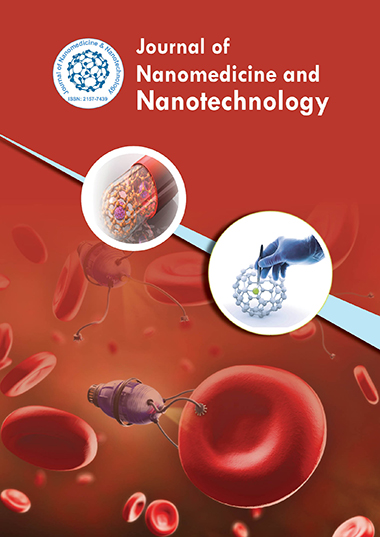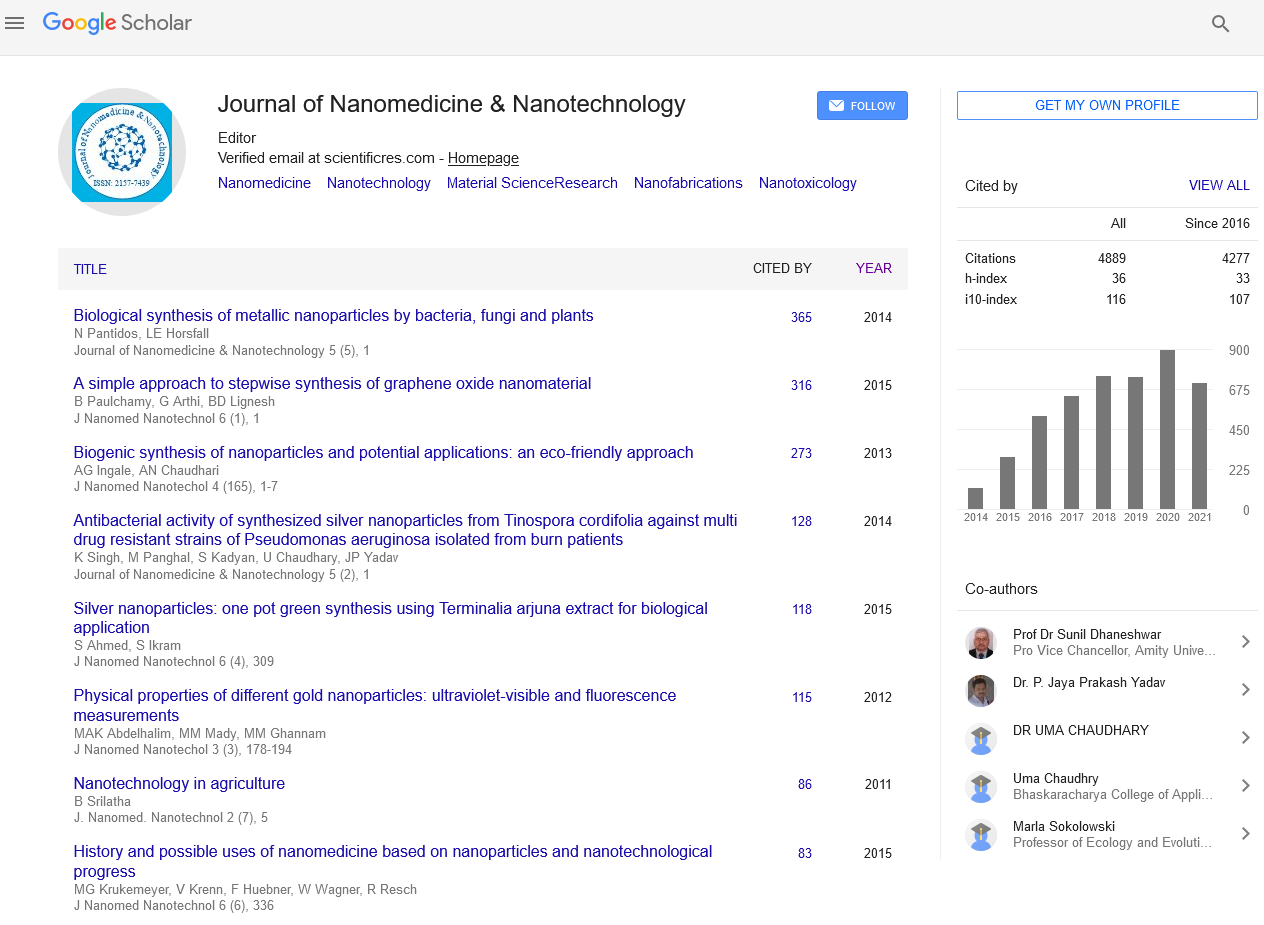Indexed In
- Open J Gate
- Genamics JournalSeek
- Academic Keys
- JournalTOCs
- ResearchBible
- China National Knowledge Infrastructure (CNKI)
- Scimago
- Ulrich's Periodicals Directory
- Electronic Journals Library
- RefSeek
- Hamdard University
- EBSCO A-Z
- OCLC- WorldCat
- SWB online catalog
- Virtual Library of Biology (vifabio)
- Publons
- MIAR
- Scientific Indexing Services (SIS)
- Euro Pub
- Google Scholar
Useful Links
Share This Page
Journal Flyer

Open Access Journals
- Agri and Aquaculture
- Biochemistry
- Bioinformatics & Systems Biology
- Business & Management
- Chemistry
- Clinical Sciences
- Engineering
- Food & Nutrition
- General Science
- Genetics & Molecular Biology
- Immunology & Microbiology
- Medical Sciences
- Neuroscience & Psychology
- Nursing & Health Care
- Pharmaceutical Sciences
Editorial - (2024) Volume 15, Issue 6
Nanostructured Superconducting Materials for Quantum Computing
Everett Quinnell*Received: 02-Nov-2024, Manuscript No. jnmnt-24-28300; Editor assigned: 05-Nov-2024, Pre QC No. jnmnt-24-28300 (PQ); Reviewed: 20-Nov-2024, QC No. jnmnt-24-28300; Revised: 25-Nov-2024, Manuscript No. jnmnt-24-28300 (R); Published: 30-Nov-2024, DOI: 10.35248/2157-7439.24.15.763
Abstract
Quantum computing is a rapidly developing field that promises to revolutionize information processing by utilizing quantum mechanical phenomena, such as superposition and entanglement. A key component of many quantum computing architectures is the use of superconducting materials, which offer zero electrical resistance and the ability to carry electrical currents without loss. These properties are ideal for creating stable qubits the fundamental units of quantum information. However, as quantum computers scale, the need for improved superconducting materials with enhanced properties becomes critical. Nanostructured superconducting materials have emerged as a promising solution to meet these demands. By leveraging nanoscale engineering, these materials can exhibit improved superconducting properties, such as higher critical temperatures, lower energy dissipation, and enhanced coherence times, all of which are crucial for the development of practical quantum computers. This article explores the role of nanostructured superconducting materials in quantum computing, focusing on their synthesis, characterization, and performance in qubit fabrication. The challenges faced in integrating these materials into scalable quantum computing systems and future directions for research in this field are also discussed.
Keywords
Superconducting materials; Quantum computing; Qubits; Nanostructures; Coherence time; Critical temperature;
Energy dissipation; scalability
INTRODUCTION
Quantum computing stands at the forefront of next-generation computing technologies, with the potential to solve complex problems that are currently intractable for classical computers. The development of quantum computers hinges on the creation of qubits, which are the quantum analogs of classical bits. Unlike classical bits, which can be either 0 or 1, qubits can exist in superpositions of states, enabling parallel processing of information and exponential speed-up in computation. Superconducting materials, which exhibit the phenomenon of superconductivity (the complete absence of electrical resistance), have been extensively studied as the basis for qubits due to their ability to maintain quantum coherence over relatively long periods. However, as quantum computers scale to more qubits, the limitations of traditional superconducting materials become apparent, particularly with regard to coherence times, critical temperatures, and energy dissipation [1]. To address these challenges, researchers are increasingly turning to nanostructured superconducting materials, which can be engineered at the nanoscale to improve their superconducting properties. These materials offer several advantages, such as enhanced coherence times, increased critical temperatures, and lower energy losses. This article explores the advancements in nanostructured superconducting materials and their applications in quantum computing, with a focus on how these materials contribute to the development of scalable and robust quantum processors [2].
TYPES OF NANOSTRUCTURED SUPERCONDUCTING MATERIALS FOR QUANTUM COMPUTING
Several nanostructured superconducting materials have shown promise for improving the performance of quantum computing systems. These materials include high-temperature superconductors (HTS), low-temperature superconductors (LTS), and nanocomposite materials that combine superconductors with other functional nanomaterials to enhance their properties.
High-Temperature Superconductors (HTS)
High-temperature superconductors (HTS), such as YBaâ??Cuâ??Oâ?? (YBCO) and Biâ??Srâ??CaCuâ??Oâ?? (BSCCO), have attracted significant attention due to their ability to superconduct at temperatures much higher than conventional superconductors, typically above the boiling point of liquid nitrogen (77 K). HTS materials, when used in nanostructured forms, can exhibit enhanced superconducting properties such as increased critical current densities, which are critical for achieving the high fidelity and low dissipation necessary for quantum computing applications.
Nanostructuring HTS materials, such as creating quantum dots or nanowires, can increase the material’s flux pinning ability, which helps to stabilize superconducting states and reduce energy loss. By controlling the size, shape, and composition of these nanostructures, researchers can fine-tune the material’s properties to optimize its performance in quantum computing devices.
Low-Temperature Superconductors (LTS)
Low-temperature superconductors (LTS), such as niobium (Nb) and niobium-titanium (NbTi) alloys, are widely used in quantum computing devices due to their well-understood properties and reliable performance. However, LTS materials require cooling to very low temperatures (below 10 K), making them less practical for large-scale systems. Nanostructuring these materials can improve their superconducting properties by reducing the effects of pair-breaking mechanisms and enhancing the phase coherence required for stable qubit operation. For example, superconducting nanowires made from LTS materials can offer higher critical currents and improved coherence times, which are essential for quantum computing applications [3].
Nanocomposites and Hybrid Materials
Nanocomposite materials, which combine superconducting materials with other functional nanomaterials such as graphene, carbon nanotubes (CNTs), and metallic nanostructures, are another promising approach for improving the performance of quantum computing materials. These hybrid materials can exploit the unique properties of both superconductors and nanomaterials, such as enhanced thermal conductivity, mechanical stability, and quantum coherence. The interaction between the superconducting matrix and the incorporated nanostructures can help mitigate issues such as energy dissipation and decoherence in qubits, thus contributing to more efficient quantum processors [4].
MECHANISMS OF ENHANCED SUPERCONDUCTIVITY IN NANOSTRUCTURED MATERIALS
The improvement in superconducting properties through nanostructuring can be attributed to several key mechanisms
Increased Surface-to-Volume Ratio
At the nanoscale, materials have a much higher surface-to-volume ratio compared to bulk materials. This increased surface area allows for better interaction between the superconducting electrons and the surrounding environment, leading to enhanced critical current densities and flux pinning. The ability to control the surface characteristics of nanostructured superconductors is particularly beneficial for quantum computing, where maintaining coherence and minimizing energy loss are crucial [5].
Quantum Confinement Effects
Nanostructuring can lead to quantum confinement effects, where the electronic properties of materials are altered due to the reduction in size. This can result in a shift in the electronic band structure and a change in the way superconductivity manifests at the nanoscale. For example, superconducting nanowires may exhibit different superconducting behavior than bulk materials, such as the ability to maintain a superconducting state at higher temperatures or under lower external magnetic fields.
Enhanced Flux Pinning
In nanostructured superconducting materials, the introduction of nanoscale defects or nanostructures can improve the material’s flux pinning ability. Flux pinning helps to prevent the movement of magnetic flux lines through the material, which is essential for maintaining the stability of the superconducting state. Nanostructured materials, such as nanocomposites or nanowires, can offer superior flux pinning characteristics, which in turn enhances the performance of superconducting qubits in quantum computing systems [6].
CHALLENGES AND LIMITATIONS
Despite the promising potential of nanostructured superconducting materials for quantum computing, several challenges remain
Material Stability and Fabrication Complexity: Nanostructured superconducting materials can be sensitive to environmental factors such as temperature fluctuations and magnetic fields, which may affect their stability and performance. Furthermore, the fabrication of nanostructures with precise control over their size, shape, and composition can be challenging, requiring advanced fabrication techniques and high precision [7].
Scalability: While nanostructured superconducting materials show excellent performance in small-scale devices, scaling these materials to the levels required for large quantum computing systems presents significant challenges. Achieving uniformity in the properties of nanostructured materials across large areas, while maintaining their superconducting behavior, is a critical obstacle to their widespread adoption.
Integration with Existing Technologies: The integration of nanostructured superconducting materials with current quantum computing technologies is another challenge. Most quantum computing platforms rely on traditional superconducting materials, and transitioning to new nanostructured materials requires substantial changes to the existing infrastructure and fabrication techniques [8].
FUTURE DIRECTIONS
The future of quantum computing depends heavily on the development of new materials and technologies that can overcome the limitations of current superconducting materials. Several potential directions for future research include
Hybrid Superconducting Systems: The combination of different types of nanostructured superconducting materials, such as HTS and LTS, in hybrid systems could offer superior performance. Research into the interactions between different superconducting materials at the nanoscale could provide valuable insights into designing more efficient and stable quantum computing systems [9].
Room-Temperature Superconductivity: The discovery of room-temperature superconductivity in nanostructured materials could revolutionize quantum computing. Although still in the early stages, research into room-temperature superconductors, particularly in nanostructured form, holds the potential to drastically reduce the cooling requirements for quantum computing systems, making them more practical for widespread use.
Quantum Coherence Enhancement: Improving quantum coherence in superconducting qubits is a key goal for advancing quantum computing. Nanostructured superconducting materials, through their unique electronic properties, could help to extend coherence times and reduce decoherence, thus enabling more reliable quantum operations [10].
CONCLUSION
Nanostructured superconducting materials play a crucial role in advancing quantum computing by providing enhanced properties such as higher critical temperatures, improved flux pinning, and reduced energy dissipation. These materials are essential for the development of stable, scalable, and efficient qubits, which are necessary for practical quantum computing. Despite challenges related to material stability, fabrication complexity, and scalability, ongoing research and technological advancements in nanostructured superconductors offer promising prospects for the future of quantum computing.
REFERENCES
- Li C, Li Q, Zeng Z, Zhou X. Dispersions of hydrophobic magnetite nanoparticles in nonpolar solvents with different surfactants: the effect of surfactant chain length and surfactant concentration. J Colloid Interface Sci. 2019;539: 567-577.
- Zhang S, Bellinger A, Genshaft A. A bloodâ??brain barrierâ??penetrating gut-microbe-derived molecule that enhances amyloid beta deposition and cognitive impairment in a mouse model. Science Advances. 2021; 7(23): eabf1773.
- Tong R, Chiang HH, Kohane DS. Photoswitchable nanoparticles for in vivo cancer chemotherapy. Proc Natl Acad Sci. 2020; 110(46): 19048-19053.
- Sarvi F, Mahmoodzadeh A, Kiani M. A novel mathematical model for the effective drug administration and the drug concentration in brain tumor. J Drug Deliv Sci Technol. 2021; 61:102275.
- Ranade A R, Zhang H, Drueckhammer D G. 3D-QSAR Models for Arylcarboxamides as Potent and Selective Human Beta 3 Adrenergic Receptor Agonists. J Chem Inf Model. 2018; 58(7): 1476-1487.
- Bai Y, Li Y, Zhang G, Hou X. Understanding the mechanisms of graphene-based nanomaterials as drug carriers: a theoretical perspective. Phys Chem Chem Phys. 2020; 22(29): 16544-16556.
- Garg S, Liao W, El-Kadi AO. Understanding the interaction of dietary polyphenols with mammalian drug metabolizing enzymes. Curr Drug Metab. 2020; 21(6): 416-429.
- Zhang Y, Zhang R, Su H. Interaction of ligand-bound nanoparticles with cell membranes: from specific binding to nonspecific penetration. Langmuir. 2019; 35(3): 677-688.
- Shi Y, Zhao R, Zhang Q, Wei Y, Zhao Y. Molecular Dynamics Simulation-Guided Rational Design of Polymer Nanocarriers for Drug Delivery. Nanoscale Res Lett. 2019; 14(1): 372.
- Jiang H, Du L, Li L. Multiscale modeling and experimental study on the self-assembly of telo-dendrimers. J Mol Model. 2021; 27(1): 1-13.
Indexed at, Google Scholar, Crossref
Indexed at, Â Google Scholar, Crossref
Indexed at, Google Scholar, Crossref
Citation: Everett Q (2024) Nanostructured Superconducting Materials for Quantum Computing. J Nanomed Nanotech. 15: 763.
Copyright: ©2024 Everett Q. This is an open-access article distributed under the terms of the Creative Commons Attribution License, which permits unrestricted use, distribution, and reproduction in any medium, provided the original author and source are credited.


